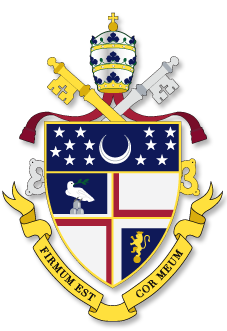Sunday: Santa Maria in Domnica
Sitting quietly by the side of the busy Via della Navicella, the Basilica of St. Mary in Domnica holds the distinction of being the station church for the Second Sunday in Lent. A tradition holds that on this location once stood the house of the Roman matron Cyriaca, from which St. Lawrence would distribute alms to the poor. At some later time, it is believed that this was the location of military barracks, or of a civil defense post. A diaconia with an attached chapel is known to have existed here from the time of the late eighth century, this possibly being established in some buildings from the military post. The name domnica might signify that this was built on land donated by the Emperor, which would make sense if its previous use was for military purposes. While the other Sundays of Lent are celebrated at the largest basilicas in the city, the station is held here today because there was originally no station for this day, the ordination liturgy at St. Peter’s on the previous day being considered the Mass for Sunday. When the liturgy was created for this day, this venerable diaconia was fixed as the station. Pope St. Paschal I replaced the diaconia with a larger basilica around the year 820. While little decoration from these times remains, one notable feature are the mosaics of the triumphal arch and apse, these being one example of the many mosaics he commissioned in churches built or repaired by him. In the mid-fifteenth century the church was near ruin, and later in that century the cardinal titular of the church, Giovanni de Medici, undertook a restoration and additions, including the fine porch. These works largely ended in 1513 when he was elected as Pope Leo X, in which office he would see the beginning of the Protestant Reformation. The basilica was again restored in the mid-sixteenth century. From then until the present day the church has seen some minor additions and restorations, but is still today essentially a structure whose appearance reminds us of those last days before Europe descended into the wars of religion of the sixteenth and seventeenth centuries.
_______________
Address: Piazza della Navicella, 10
Directions: Take bus 40 or 64 from the Acciaioli stop (in front of S. Giovanni dei Fiorentini) to Piazza Venezia. Then take bus 81 past the Colosseum to via della Navicella. The church is on the right.
